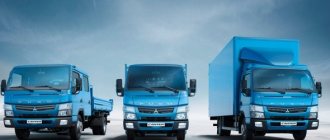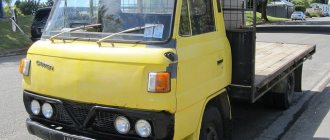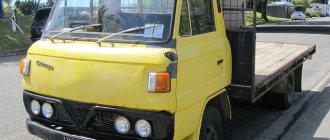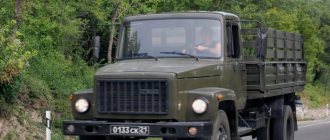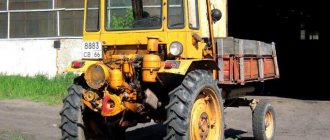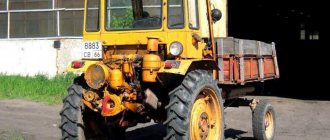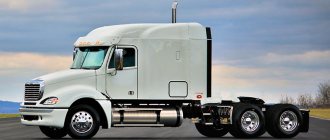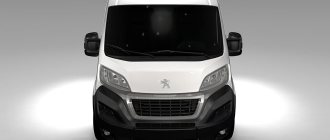Fuso from an operational perspective
Daniil Minaev, photo by the author
| Manufacturer: | DAIMLER KAMAZ RUS LLC (Russia) |
| Model: | Mitsubishi Fuso Canter FE85DJ |
| Body model: | 47064 |
| Body manufacturer: | Automechanical Plant LLC (Kudma village, Nizhny Novgorod region, Russia) |
| Start of sales in Russia: | 2016 |
Recently, an auto company friendly to me, whose fleet is based on small and medium-tonnage postal vans on South Korean KIA and Hyundai chassis, has been replenished with Japanese trucks, Russian-assembled Mitsubishi Fuso Canter 2016 with add-ons - isothermal vans. This was the reason for a visit to find out some of the nuances in comparison against the background of its closest competitors.
I remembered a short but emotional acquaintance with the all-wheel drive version of the Mitsubishi Fuso Canter (4x4) two years ago in the vicinity of Hannover. Then it was, rather, an all-wheel drive “hut on chicken legs” for the European market, where the issue of cross-country ability is not as pressing as in Russia. But even despite the relevance of off-road, we also have no reason for the mass purchase of these SUVs. Almost throughout the entire territory of the former USSR, an ordinary delivery van is a five-ton 4x2 for urban delivery work. Although why only for urban?
Old friend: modest interior
Perhaps, still only for urban distribution.
I climbed into the cabin, and again I was greeted by a kingdom of square panels and right angles - the age of this interior is almost my age, as designers painted in the early eighties. Compared to the European versions, Naberezhnye Chelny receives slightly different vehicle kits, and the engine for Europe is completely different: smaller displacement, but similar in power and torque.
The Russian Fuso Canter has a different instrument cluster, a simpler front panel, doesn’t even have a full-fledged locking glove box, and the velor seat upholstery, although it looks elegant, needs to be covered, otherwise it will quickly wear out. And yet, despite the modest size of the three-seater cabin, there is little space for outerwear and things behind the backs of the seats. In the leg area, surprisingly, there is quite enough space, and my two-meter-tall colleague settled into his workplace without any problems, moving the seat back and adjusting the steering column, which is adjustable in angle and reach, to suit him.
To check the level and, if necessary, add brake fluid and windshield washer, the driver will have to “play hide and seek”, of course, if he has not previously worked on Asian trucks
The suspended clutch and brake pedals are nostalgically diluted with a floor-mounted accelerator. The visibility from the mirrors would be good if it weren’t for the huge bulk of the body. Conclusion: this cabin is only convenient for the city and daytime suburbs, but what a gorgeous van!
Isotherm silhouette
When I looked at the already familiar silhouette of the Japanese five-ton, I recognized with some bewilderment the fact that small wheels (215/75 R17.5), a rather long wheelbase and a bulky isothermal van, produced by Automechanical Plant LLC, piled onto an elegant chassis, together create a solid the image of a compact but roomy truck. The transport company managed to find such a car for a rather picky customer.
He will have to transport consolidated cargo of perfume products, which weigh little due to the large volume of packaging and are susceptible to cold and heat. And most importantly, perfume and cosmetics require at least some positive temperature in the van in winter (winter mode requires from +2 to +6 °C). To do this, the isothermal van had to be retrofitted with an autonomous air heater “Planar”. We argued for a long time, but reluctantly decided to place the heater under the ceiling: it’s bad from the point of view of convection, but if the fragile plastic heater housing, complete with supply hoses and electrical wiring, ends up on the floor of the van, it definitely won’t last long, and you won’t be able to put it away in the casing. It’s not cheap to install a “eutetics” nowadays, and in light of the latest trends, government agencies are right there with their paper bureaucracy - formalize the re-equipment and changes to the design, otherwise the registration will be canceled, there have already been precedents. Customers and those comrades are fickle. Having weighed all these circumstances, we were satisfied with the “Planar” hanging from the ceiling - relatively cheap and really cheerful.
SUSPENSION
The frame is a spar ladder with a profile height decreasing at the front. Since the Cantera model range includes cars with seven base options, from 2500 to 4470 mm, it would be expensive to make frames of different lengths and even with a variable cross-section at the front and rear. The height of the side members in the middle is 226 mm, the width of the shelf is 70 mm, the thickness is 6 mm. However, short ones are not collected in Chelny; there are only four base options: 3410, 3870, 4170 and, the longest, 4470 mm. A six-meter van or flatbed can easily fit onto this one - one of the sizes most in demand by carriers. At the same time, sufficient maneuverability of the vehicle is maintained: thanks to the large steering angles of the wheels, the turning radius of the longest one is only 7.8 m.
The drive of the drum brakes with automatic clearance adjustment is double-circuit hydraulic, with an anti-lock braking system, a vacuum booster and, which is not found on passenger cars, a brake force regulator on the rear axle. The need for a “sorcerer” is caused by a significant difference in the weight of an empty car and a loaded one. With a chassis weight of just over 2.6 tons, the load capacity is almost 5 tons! Let us note, by the way, that the KamAZ-4308, with the same carrying capacity and purpose (essentially a delivery truck), weighs about 4.5 tons. And even though it is 10% cheaper, the buyer is increasingly choosing a modern and efficient vehicle - a portfolio of orders for “ Kanter" is filled two months in advance. And in the future they are going to master the assembly of the Fighter. Its total weight is 12 tons, of which the chassis is only 4 tons.
Achilles' heel and technical finesse
The truck, with a gross weight of 8500 kg and a dead weight of 4295 kg, is driven by a four-cylinder four-stroke turbodiesel (turbocharger with variable turbine geometry and intercooler) model 4M50-5AT5 with a power of 180 hp. Power supply system – Common Rail. Ecological class – fourth. By the way, if you crawl under the car from the front, you can see that the charge air cooler, which is the first in the radiator bundle, is slightly tilted back, which makes the cooling devices almost invulnerable to stones and other unpleasant surprises. But the Achilles heel of this engine in normal operation was the water-oil heat exchanger. The thin arteries inside are afraid of the emergence of an aggressive environment if there is old or low-quality antifreeze in the system and have a tendency to “peptic ulcers.” An alarming symptom - a sudden increase in the level of coolant in the expansion tank requires immediate intervention, and after eliminating the cause of the malfunction, replacing the engine oil and antifreeze. If the heat exchanger is not available in the spare parts warehouse or in the nearest store, then you can get by as a temporary measure by installing a plug. As practice shows, there is no significant change in the temperature of the engine. In all other respects, this diesel engine is unpretentious and rarely announces the approach of retirement age before a mileage of 200,000 km.
The engine is coupled with a 6-speed manual gearbox - simple, but not devoid of a certain technical elegance: it has a snail's 1st gear and the ability to take power to drive a hydraulic pump for additional equipment of a possible variety of add-ons (gears from II to VI are synchronized; gears of 1st gear and reverse gear - constant engagement).
The brake system is hydraulic, the parking brake is transmission, on the secondary shaft of the gearbox, the front has ventilated disc mechanisms with floating brackets - this is a recent innovation (previously there were drums on all axles), the rear remains with classic drum mechanisms. There is also a vacuum type motor retarder with a throttle valve. There were no obvious punctures or weak points in the brakes during operation; one can only complain about the outdated footings in the rear wheel fasteners. The cardan drive serves for a long time faithfully with regular maintenance in the form of lubricant, but if it is necessary to replace the outboard bearing, it requires its (the bearing) to be installed correctly (meaning orientation in the direction of rotation, surprisingly, but for some reason this is often the sin of car service centers, and not during handicraft repairs), otherwise the service life of the replaced part is noticeably shorter.
In the chassis, everything is according to the classical scheme - spring suspensions on both axles, however, the front springs are on silent blocks, while the rear springs are on bushings, which require regular lubrication through the existing grease nipples. The front axle is an I-beam with steering knuckles, the rear axle is with completely unloaded axle shafts. The steering mechanism is a ball nut-rack-sector with a built-in hydraulic booster. Here, perhaps, in brief, is all the basic information necessary for the trouble-free operation of the relatively new Fuso, as the mileage increases, I think there will be more to share, but next time. Now a little about how the car behaves on the move.
ENGINE
“Mitsubishi 4D50–7AT7” is a real diesel truck with a timing drive by gears from the front crankshaft toe and two camshafts in an aluminum cylinder head (with four valves per cylinder). Two camshafts are a design highlight that is rarely found in commercial diesel engines. And there is another grain of zest - two balancer shafts! On in-line “fours” with a cylinder capacity of just over a liter (motor size 114x120 mm), such concern for reducing vibrations is rarely seen. The liners are dry, which virtually eliminates their cavitation destruction, and at the same time reduces external noise: a more rigid structure vibrates less. The power system is an electronically controlled common rail with three-portion fuel injection, manufactured by Bosch. Accordingly, there is no crackling injection pump and no clanking injection advance clutch. Perhaps that is why the softness of the operation of the Chelny “Fuzo-Canter” catches the ear - even if it is frozen after an overnight stay, even if it is warmed up, the engine runs smoothly and quietly.
This engine meets Euro-3 standards with EGR (Exhaust Gas Recirculation) exhaust gas recirculation with liquid cooling and a turbocharger with an adjustable turbine. For Euro-4, when it is introduced in Russia, a particulate filter will be installed, and with the arrival of Euro-5, they plan to equip the car with an Iveco-developed engine with a ZF gearbox. But until this time has come, Canter has some competitive advantage - colleagues who rushed to promote ecology will not go back (previous models have been discontinued) and are forced to make more expensive engines.
Simply beautiful on the go
The acceleration dynamics are simply excellent, and it’s not so scary to catch a small hole or bump: the soft, energy-intensive suspension copes with this without difficulty and does not cause swinging or rearranging - five points (on a five-point scale) for the settings. I was also pleasantly surprised by the extremely clear operation of the cable drive of the manual transmission - all gears are faultless and are engaged with a pleasant fixation, and the elastic motor confidently moves out from somewhere around 1300 rpm. On the highway, our little hard worker will not feel inferior. If desired, it can be accelerated to 108 km/h (nameplate data). You just need to be careful with your visibility - the van is too wide and the mirrors are very primitive, not allowing you to see even the rear corners of the body.
Perfume and cosmetics require a positive temperature in the van in winter. To do this, the isothermal van had to be retrofitted with an autonomous air heater "Planar"
The general impression is that of a solid and somewhat faceless truck, which occupies almost the maximum price niche in its segment, but is quite liquid on the secondary market, even when quite aged and with high mileage, the “fault” for this is the fifty-year history of the model. What’s noteworthy is that the set of advantages and disadvantages is absolutely similar to the Korean and Japanese competitors due to the identity of the design, like twin brothers, or is it so obvious to peek in the east, or what? There is nothing more to add...
Technical characteristics of the AMZ 47064A van on the Fuso Canter FE85DJ chassis
| Parameter | Meaning |
| Wheel formula | 4x2 |
| Total weight, kg | 8500 |
| Curb weight, kg | 4295 |
| Permissible weight of a towed trailer equipped with brakes, kg | 3500 |
| Permissible weight of a towed trailer, not equipped with brakes, kg | 750 |
Engine:
| Mitsubishi Fuso 4M50-5AT5 Turbodiesel, I-4, Euro 4 4899 179.5 at 2700 min-1 530 at 1600 min-1 |
Transmission
| Mitsubishi M036S6, manual 6/1 |
| Gearbox ratios | I – 5,400; II – 3.657; III – 2.368; IV – 1.465; V – 1,000; VI – 0.711; Z.x. – 5,400 |
| Fuel tank capacity, l | 100 |
| Maximum speed, km/h | 108 |
| Tires | 215/75 R17.5 |
TRANSMISSION
Mitsubishi Fuso Truck and Bus Corporation has its own production of manual transmissions and drive axles. If you come across a Canter with a robotic gearbox or a classic automatic transmission with GMP, then these units are made in Japan -. It is part of the Toyota concern, and its clutches and gearboxes are in great demand among many Japanese, Korean and even American car factories. The car, assembled in Chelny, is equipped only with a six-speed manual gearbox.
The rear axle is hypoid, with a single gear ratio of 5.714. But there is a self-locking differential.
Half a century – a lot or a little?
Canter celebrates its 54th anniversary in 2022.
Since 1963, almost 4 million cars of eight generations have been sold worldwide. The name Canter was chosen for the Japanese truck due to its association with horse endurance. The first generation T720 was produced for 5 years until 1968, and then gave way to the T90 series. Another 5 years later, the third generation T200 with a lifting capacity of 2.5 and 3 tons appeared, and in 1978 the fourth FE1 with a narrow and FE2 with a wide cabin and a lifting capacity of 2 and 3 tons, respectively.
The fifth generation FE3 with a 130-horsepower turbodiesel was released in 1985 simultaneously with all-wheel drive versions of the FG3. These trucks became one of the first Japanese light-duty trucks officially imported to the USSR and the Russian Federation. In 1991, the millionth Fuso Canter was sold in Japan. The sixth generation FE5 and FE6 with improved aerodynamics was launched in 1993. By the end of the 1990s, a number of Russian enterprises began producing vans and special vehicles based on them.
In 2000, an alliance between Mitsubishi Fuso Truck and Bus Corporation and Daimler Truck Group took place; the truck’s update continued in 2002: the seventh generation FE7 was adapted to international requirements. In 2005, sales of TD versions with Euro 4 engines with a Common Rail injection system began. A year later, the first generation of Fuso Canter Eco Hybrid was introduced; 2009 was marked by the appearance of the eighth generation. Since 2013, the second generation Fuso Canter Eco Hybrid hybrid version has appeared, and finally the youngest all-wheel drive version.

